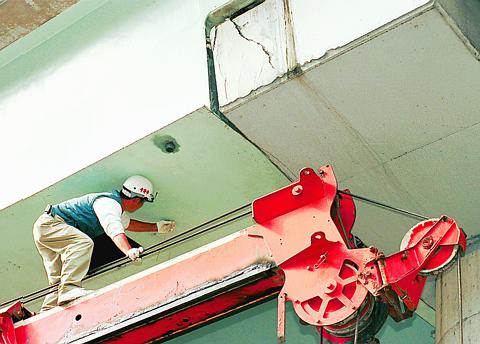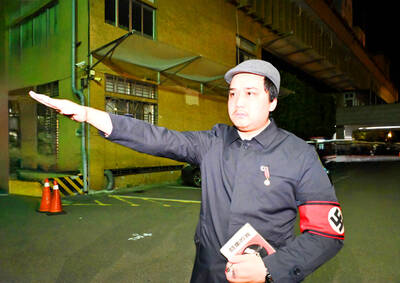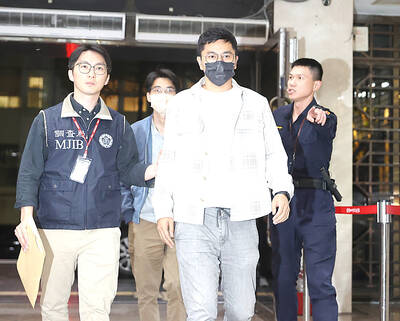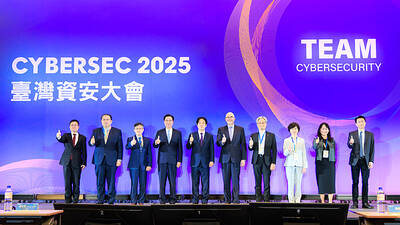In the latest debacle to hit the city's troubled rapid transit system in the past month, a crack was created yesterday in a pillar of the MRT Mucha line while subcontractors carried out maintenance work.
Department of Rapid Transit Systems (DORTS) the government body in charge of construction for the line, blamed the problem on faulty maintenance by subcontractors.
During a routine maintenance check of the lightweight Mucha line early yesterday morning, Chunghua Engineering Company, the subcontractors that built pillars for the elevated line, said they created a crack about one centimeter wide in one pillar between the Chungshan Middle School and Nanking East Road stations.

PHOTO: CHIANG YING-YING
Following the discovery, the Taipei Rapid Transit Corporation (TRTC) stopped trains on the stretch of track north of the intersection of Chunghsiao and Fuhsing Road and ran a free bus service for commuters.
DORTS said they planned to spend 24 hours working on the line and restore operations to normal as quickly as possible.
But DORTS spokesperson Ling Chi-yao (
Consultants yesterday were examining the crack and suggesting longer-term measures for fixing the problem, but DORTS' initial assessment was that a pin between the pillar and the track was put in the wrong position when Chunghua Engineering was trying adjust a tilted connection between the pillar and the track.
Several years of wear and tear from trains travelling overhead had created the tilt, said Ling.
A spokesperson for Chunghua Engineering was at first reluctant to acknowledge that incorrect placement of the pin during construction was the cause of the crack, saying that this was definitely an "accident." But when pressed said, "Yes, the pin was in the wrong place."
Chunghua had placed temporary metal "H-pins" as support around the crack, and DORTS consultants would recommend longer-term measures, he said.
The appearance of the crack yesterday is just the latest in a long series of mishaps for the MRT.
Cracks first appeared in pillars themselves after test runs on the Mucha line began in the early 1990s -- just several years after construction by the line's many subcontractors began in 1988.
During the two years of test runs between 1992 and 1994, trains derailed twice and brakes on trains caught fire twice.
Another of the dozens of subcontractors on the Mucha line, the France-based Matra Transport Co., has been locked in years of legal battles with DORTS over cost overruns and delays during construction. Matra built several portions of the Mucha Line, including the trains themselves and large sections of stations.
The majority of recent problems with the MRT system have been on the heavy-traffic network -- the Tamshui, Chungho and Hsintien lines.
In the last month alone, the TRTC's new mainframe signal computer on that system has failed at least three times, causing major delays, near misses between trains in tunnels and inconvenience for commuters.
The TRTC is now under intense pressure less than a month before its goal of opening a section of the new Panchiao-Nankang line before the end of this year.
TRTC spokesperson Henry Chen (

‘FORM OF PROTEST’: The German Institute Taipei said it was ‘shocked’ to see Nazi symbolism used in connection with political aims as it condemned the incident Sung Chien-liang (宋建樑), who led efforts to recall Democratic Progressive Party (DPP) Legislator Lee Kun-cheng (李坤城), was released on bail of NT$80,000 yesterday amid an outcry over a Nazi armband he wore to questioning the night before. Sung arrived at the New Taipei City District Prosecutors’ Office for questioning in a recall petition forgery case on Tuesday night wearing a red armband bearing a swastika, carrying a copy of Adolf Hitler’s Mein Kampf and giving a Nazi salute. Sung left the building at 1:15am without the armband and apparently covering the book with a coat. This is a serious international scandal and Chinese

PERSONAL DATA: The implicated KMT members allegedly compiled their petitions by copying names from party lists without the consent of the people concerned Judicial authorities searched six locations yesterday and questioned six people, including one elderly Chinese Nationalist Party (KMT) member and five KMT Youth League associates, about alleged signature forgery and fraud relating to their recall efforts against two Democratic Progressive Party (DPP) legislators. After launching a probe into alleged signature forgery and related fraud in the KMT’s recall effort, prosecutors received a number of complaints, including about one petition that had 1,748 signatures of voters whose family members said they had already passed away, and also voters who said they did not approve the use of their name, Taipei Deputy Chief Prosecutor

UNDER ATTACK: Raymond Greene said there were 412 billion malicious threats in the Asia-Pacific region in the first half of 2023, with 55 percent targeting Taiwan Taiwan not only faces military intimidation from China, but is also on the front line of global cybersecurity threats, and it is taking action to counter those attacks, President William Lai (賴清德) said yesterday. Speaking at the opening of this year’s Cybersec Expo in Taipei, the president assured foreign diplomats and exhibitors that Taiwan remained committed to strengthening its defense against cyberattacks and enhancing the resilience of its digital infrastructure. Lai referenced a report from the National Security Bureau (NSB) indicating that the Government Service Network faced an average of 2.4 million intrusion attempts daily last year, more than double the figure

COUNTERINTELLIGENCE TRAINING: The ministry said 87.5 percent of the apprehended Chinese agents were reported by service members they tried to lure into becoming spies Taiwanese organized crime, illegal money lenders, temples and civic groups are complicit in Beijing’s infiltration of the armed forces, the Ministry of National Defense (MND) said in a report yesterday. Retired service members who had been turned to Beijing’s cause mainly relied on those channels to infiltrate the Taiwanese military, according to the report to be submitted to lawmakers ahead of tomorrow’s hearing on Chinese espionage in the military. Chinese intelligence typically used blackmail, Internet-based communications, bribery or debts to loan sharks to leverage active service personnel to do its bidding, it said. China’s main goals are to collect intelligence, and develop a